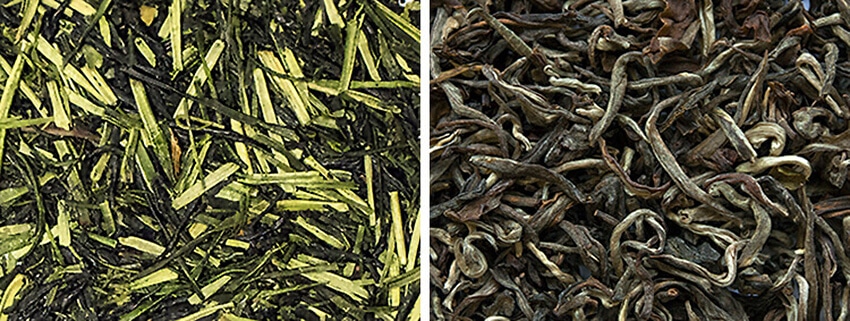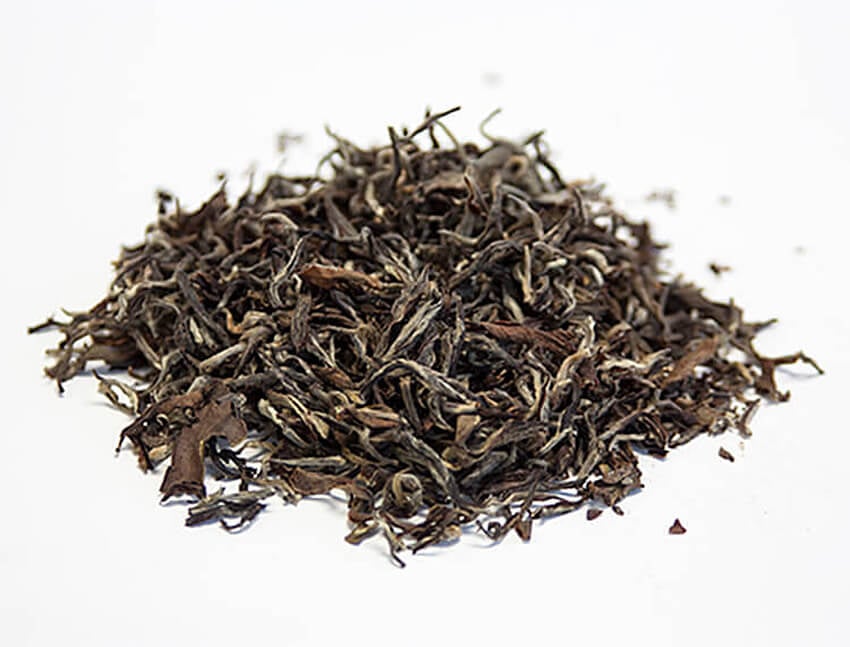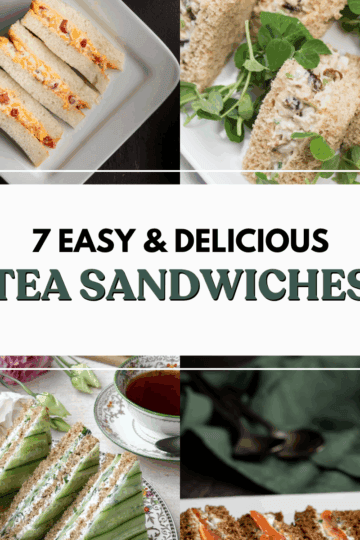Discover the rich and diverse world of loose leaf tea in this article from Tegan Woo, former founder of Amoda Tea.
If you’re a tea lover eager to explore beyond tea bags, this beginner’s guide to loose leaf tea will introduce you to the many varieties available and help you find your perfect cup.

Editor’s note: As a tea lover, I ventured beyond grocery store tea bags and found the world of loose leaf tea to be vast and overwhelming. To learn the basics, I turned to Tegan Woo, founder of Amoda Tea, who generously created this beginner’s guide to loose leaf tea.
Jump to Section:
☕️ What is Loose Leaf Tea?
Tea is the oldest beverage in the world and an essential drink in cultures all across the globe.
All true "tea" is made from the leaves of the Camellia Sinensis bush. This includes black, oolong, green, white, yellow, and pu-erh.
Despite the fact that all of those teas come from the same plant, each tea is unique. This is from a combination of differences in terroir from region to region (just like wine), the season the leaves are plucked, changing climate conditions, the farmer's technique in processing the leaf and the many ways we steep them!

What about herbal teas?
Herbal teas like chamomile, mint and rooibos tea are not technically "tea" because they don't come from the Camellia Sinensis plant. However, many of us still refer to them as "tea" and that's perfectly fine!
🌱 Types of Loose Leaf Tea
If all true tea comes from the same plant, then the difference in the final tea must come from the manufacturing, right?
This is true - the manufacturing process is specific to each class of tea.
There are six different types of tea: green, yellow, white, oolong, black, pu-erh. You don't see yellow tea much in North America, so we won't cover that one here.
Think of the teas along a spectrum of oxidation.
Oxidation is the exposure of the tea leaves to oxygen in the air, which causes browning of the leaves. This is similar to how an apple browns after you cut it.
Green tea is not oxidized at all and white tea is lightly oxidized.
Black and pu-erh teas are on the opposite end of the oxidization spectrum and have darker brown leaves, infusions, and produce a deeper, more hardy flavour.
Oolong covers a range of oxidation in the middle of the spectrum.
Green Tea
After the initial drying stage, leaves destined for green tea are heated to kill the enzyme responsible for oxidization.
In China, the heating is done primarily by pan-firing or roasting.
In Japan, they steam the leaves.
These different methods plays a big part in why Chinese green teas taste and look so much different from Japanese green teas.

What Does Green Tea Taste Like?
Generally speaking, Chinese green teas have a wider range of flavours and sometimes a smokiness. They're also more of a yellow-green colour.
Japanese green teas are more "fresh" tasting with vegetal, grass and seaweed notes. They're a more true green colour in the cup and tend to be more delicate than Chinese green teas.
You should visit your local tea supplier and get a Chinese green and a Japanese green and compare them at home.

What Is Matcha?
Matcha is a finely ground tea made from green tea leaves. What sets matcha apart is its unique growing and processing methods, which involve shading the tea plants before harvest and then stone-grinding the leaves into a powder.
White Tea
White tea undergoes the least amount of processing.
Only the tender young spring buds are used. The buds are allowed to wither then dry to prevent much oxidation of the leaf.

What Does White Tea Taste Like?
Because of the minimal processing, white tea is the most gentle and delicate in both look and flavour.
White tea offers a light and refreshing cup with light steamed vegetal flavours and sometimes light toasted bread.
Oolong Tea
Oolongs are the most complicated teas to manufacture!
Oolong teas are made from large tea leaves. The appearance (form, shape, colour) of finished oolong teas can range from light green to brown, long & twisted or rolled into tight little balls.
There's so much personalization and intricacy that goes into Oolong manufacture that they tend to have the widest array of flavours and aromas.
Some taste and smell of stone fruits, honey, floral (orchid is common), sandalwood and more.
You might hear oolong tea referred to as "semi-oxidized" loose leaf tea. Oolongs tend to be more oxidized than white teas, but less than black. The range is anywhere from 35% to 80% oxidation level.

What Does Oolong Tea Taste Like?
Your cup of oolong will vary in flavour depending on the amount of oxidation.
It may be sweet, creamy and soft (high mountain Taiwan), or roasty toasty (Chinese Wuyi).
Black Tea
Black teas go through a long manufacturing process.
They are withered (dried) after plucking, which is an incredibly important step in creating a solid foundation for further processing.
After withering, black teas are rolled to release enzymes from the leaf and then they are fully oxidized.
Some of the most famous black teas come from single regions and are named that way - Assam and Darjeeling in India and Keemun and Yunnan in China, for example.
Of course, we commonly see black tea as blends such as English Breakfast and Afternoon blends.
You might also see black tea as "broken leaf" and "full leaf". Broken leaf teas allow for faster and fuller extraction and more caffeine, so you'll see them more often in breakfast blends meant for the addition of milk and sugar.

What Does Black Tea Taste Like?
Again, there's a big variation in how black teas taste, but they are generally richer, stronger and darker than the previous teas, with a bit more caffeine.
Chinese black teas tend to have smoky notes and sometimes some chocolate and sweetness.
Indian teas can be heartier and bolder, with the exception of Darjeeling, which is lighter and refreshing.
Best to get out there and just start comparing them!
Pu-erh Tea
There are two types of pu-erh tea: Sheng pu’er (“raw” or “green”), which is not oxidized and Shou pu’er (“cooked” or “black”), which is oxidized.
Sheng pu-erh is the most prized. It is an investment – bought young and set aside to age.
Shou pu-erh is less expensive, but still delicious, and the type that you would normally buy to drink right away.
Like any other tea, there are varying quality levels. Pu-erh tea is the one type of loose leaf tea that is truly fermented.
Microflora and bacterial activity takes place on the leaf, actually fermenting the tea.

What Does Pu-erh Tea Taste Like?
Pu-erh teas are dark, earthy and hearty.
🫖 How Do You Brew Loose Leaf Tea?
The most simple way to brew loose leaf tea is to pour hot water over the leaves, let it steep, and then sip it carefully to avoid consuming the leaves.
However, there are nuances in the amount of tea you use, the temperature of the water, and the steeping time that can greatly affect the flavour of every tea.
To learn more about brewing tea, check out this article on How to Make Loose Leaf Tea.
Earl Grey tea is actually a flavoured tea, not a type of tea. Most Earl Grey teas are made from black tea flavoured with oil of bergamot (a citrus fruit).
This guide on loose leaf tea for beginners was originally published on June 09, 2015 by Tegan Woo. It has since been edited and re-published by Shareba Abdul. All images are credited to Tegan Woo.
Please note that specific products mentioned may not be the exact ones that Tegan recommended, as product listings have changed over the years.
This is not a sponsored post. Links to Amoda tea products are not affiliate links.






Tessa says
Hello!
In nee to creating my own herbal tea blends and am having trouble finding out if certain herbs are compatible with others, like skullcap and licorice root. Aby advice on where to find more information like this would be so helpful. Thank you!
Shareba says
Hi Tessa, I'm not an expert in that area unfortunately. However, I do have a blogger friend who writes about tea. She might be able to help you out! Here's one of her articles to get you started: https://theteacupoflife.com/2021/06/the-art-of-tea-blending-creating-your-own-tea-blends.html
Megan says
Thank you. I love tea but in an unsophisticated -grocery store-tea bag kind of way lol! I have bought the tools to steep my own from loose leaf and am now learning more about the different types of tea and brewing them. I read parts of this article outloud to my husband because it had lots of info that we didn't know. Thank you for educating people who want to learn more about tea and thank you for doing it in the way that you did in this article. It is easy to read and understand.
Shareba says
Hey Megan, I'm glad that you found the article helpful! We're hoping to get more tea content on the website soon. Let me know if there's anything else you want to learn about tea 🙂
Christina says
Hi,
I just got an Amoda Tea subscription for Xmas. My first box arrived yesterday, but I can't figure out how to use the paper tea bags included without having them open up and leak leaves into the tea. I can't find any instructions on the website or in the box either. I feel like a dummy but could you please explain it? I think this info should be easy to find on your site, but I can't find it anywhere so maybe I'm just overlooking it somehow.
Thanks
Shareba says
Hey Christina,
I don't have instructions on how to use Amoda's tea bags on my website (it's not my company), but I have forwarded your question to the owner of Amoda. She should be in touch with you soon.
Meanwhile, this is how I use the bags: I open the top, put in about a teaspoon of loose leaf tea, then fold the top part over. I then run my fingernail across the folded part (as if you were folding paper to make a card), so that it has a sharp crease. This helps the bag stay closed. Tegan from Amoda might have a better tip, but that's what I do. I hope that makes sense!
Tegan says
Hi Christina!
Great question. We do something similar to Shareba. We put a teaspoon of tea into the filter through the angled opening. Then we simply place the closed end into our mug, fill with water and let the open end drap over the edge of the mug. Then when it's done steeping you have that part that is still out of the water to grab and dispose of the filter. The water of course absorbs up through top of the filter, but it shouldn't be enough to drip over the edge of the cup. I hope that makes sense!
TEgan
Tegan says
Oh, I also wanted to mention that you could tie a knot in the top of the tea filter if you were wanting to submerge it. It's not ideal because you end up giving the tea leaves less room to move around, expand and release all the flavours, but it works in a pinch.
Nicole Martin says
Great article! Tegan really knows her stuff. I made the switch to loose leaf years ago and it's a game changer. There is so much depth and complexity to tea, even without adding any additional flavors or ingredients.
Shareba Abdul says
I'm glad you liked it Nicole! Tegan is a wealth of information when it comes to tea 🙂
Tegan says
That's a big compliment coming from you! Thanks Nicole 🙂
Janice @Kitchen Heals Soul says
I loved this post! It's so interesting to hear where the different teas come from and how the processing affect the taste!
I am pretty addicted to Typhoo tea (the great British tea, as their slogan goes). It's grocery store tea and it's pretty strong (and probably not very good quality), but I love it for breakfast with a good splash of milk . I wonder if Amoda Tea would have a nice substitute to suggest (that might be a little better quality).
Tegan says
Hi Janice, absolutely! I used to be a Tetley girl, so I know where you're coming from! We carry a breakfast blend that I really love. It's called Sock It To Me and is a strong black tea blend. It's not quite as strong as the Typhoo because Typhoo is a broken leaf tea and therefore a lot is extracted very quickly. Sock It To Me is a blend of organic and fair-trade teas, it's really smooth and bold and tastes great with milk! It's one of our biggest sellers and I'm personally a big fan 🙂 Here's the link if you'd like to check it out: [link expired]